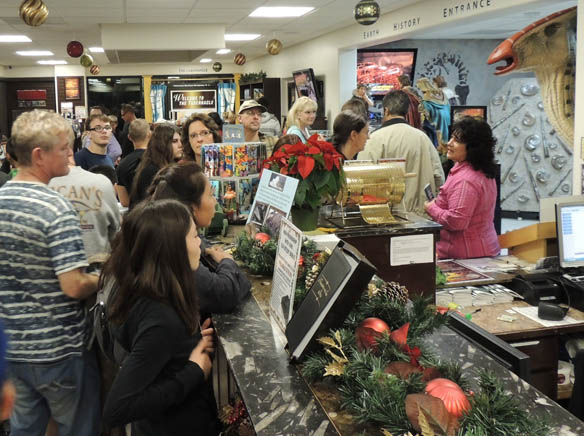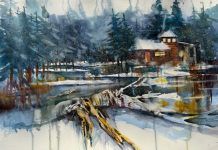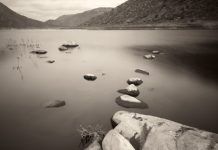A light blanket of clouds covered the sky over the Creation and Earth History Museum in Santee. The full moon, peeking through a hazy ring, perched high in the sky. The night was not a good one to peer through the telescope, but stars and planets were still the highlight of the Christmas under the Stars event.
In front of the museum under falling flakes of artificial snow, amateur astronomer Stephen Grill dazzled the minds of children and adults as he talked about moon dust.
Grill picked up a miniature model of a lunar module.
A light blanket of clouds covered the sky over the Creation and Earth History Museum in Santee. The full moon, peeking through a hazy ring, perched high in the sky. The night was not a good one to peer through the telescope, but stars and planets were still the highlight of the Christmas under the Stars event.
In front of the museum under falling flakes of artificial snow, amateur astronomer Stephen Grill dazzled the minds of children and adults as he talked about moon dust.
Grill picked up a miniature model of a lunar module.
“The astronauts were scared that they’d be landing on a mountain of dust because it had been estimated that the moon was 4.6 million years old. That’s a lot of dust,” he said.
Everyone laughed.
“But guess what? The astronomers found only a quarter inch of dust on the moon. That points to the moon being only 6,000 years old,” Grill said, the artificial snow whitening his hair. “Time and time again, we find evidence for a younger earth. The bristlecone pines, the oldest living organism on earth, are 4,300 years old. The Great Barrier Reef is also 4,300 years old.”
Grill picked up a model planet earth with a revolving stick.
“The earth is slowing down, a micro-inch a year, which is not too much,” he said. “We are now revolving at 1,000 miles an hour.”
Children giggled, adults smiled and shook their heads.
“So that means that if the earth is a million or billion years old, it would have been revolving this fast near the beginning of time,” Grill said, twirling the miniature earth on a stick. “All the dinosaurs would have flown off the earth into space.”
People burst out laughing. After they thanked him and shook his hand, they went inside to mingle in the bookstore and get cookies and hot cider. They explored the museum that explained the story not just of the human race but all of the heavens and earth.
“The museum has always been one of our favorite places to come,” said Sharen Marechale, who attended the event with her husband Russell.
“We visit here often,” Russell said.
Children munched on cookies and hot cider before heading to the auditorium to listen to singing by Grace Notes, a choir of Heritage Christian School.
And then it was time for “Astronomy and the Advent of Christ” by the featured speaker Spike Psarris, a former engineer of the U.S. military space program.
Psarris explained that he had been an atheist when he went into the space program.
“An atheist because I was an evolutionist,” he said. “But I became a Creationist when I saw how the mathematical models of evolution didn’t work. Shortly after I became a Creationist I became a Christian. You don’t have to put on blinders to be a Christian.”
Psarris explained that Advent simply meant the arrival of Christ.
“The whole story of the birth of Christ can be found in the Gospel of Luke,” he said. “But the big question for the evening is—What exactly was the Star of Bethlehem?”
Some scientists say that the star could have been a supernova. But such objects cause violent action in space, Psarris said, so that throws out the supernova hypothesis. Other scientists speculate that it was a comet; still others, a conjunction of several objects in the sky. The real problem of what was the star, Psarris said, is in scripture. Read the passage, he said, and note that the star somehow moved with the shepherds to guide them to the Christ child.
“If so, that’s a supernatural event,” he said. “So I’m among many who say the star is a mystery. That makes people uncomfortable sometimes. They want answers. So let’s look at astronomy over all to explain Advent.”
Psarris launched into a fascinating, detailed story of stars, galaxies, orbits and planets and their behavior in conjunction with gases, cooling and heating, gravity and collisions in space. It was enough to make people’s heads spin, but they smiled and nodded, taking it all in.
“The formation of stars is one of the most fundamental problems in astronomy. But without stars, you don’t have galaxies,” Psarris said. “Okay then, what about the Big Bang itself? If you look at that theory, it basically goes like this. In the beginning, there was nothing. And then it exploded.”
Laughter rippled through the audience.
“So you see the creation of the universe is basically a philosophical question. How can something come from nothing?” Psarris concluded.
After the lecture, people went to the petting zoo outside to cuddle rabbits, goats, and sheep from Manzanita 4H. Callie Caton, 13, and her sister Emily, 16, stood nearby, watching.
“What impressed me most about this evening,” Emily Caton said, “was when Mr. Psarris showed the delayed photo of a dark piece of sky and you could see all the billions of galaxies and stars, and then he said that that piece of sky was as small as a grain of sand.”
Her sister said she appreciated how Mr. Psarris explained how much order there was in the universe.
“I don’t know a lot about stars, but it’s plain to me there’s a God of order in control,” she said.
The Christmas under the Stars event was the 4th annual. The Creation and Earth History Museum is located at 10946 N. Woodside Avenue in Santee.














